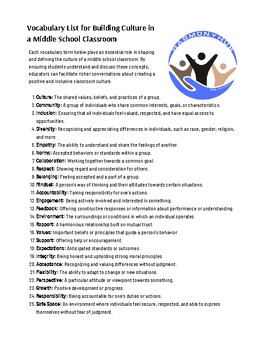Building Culture and Community Vocab. List
- PDF
Description
Description: The Vocabulary List for Building Culture in a Middle School Classroom is a curated set of terms and definitions to foster a robust understanding of the principles and practices essential for creating a positive, inclusive, and nurturing classroom environment. The selected words are particularly relevant to the dynamics, challenges, and opportunities in middle school settings, a period marked by significant developmental and social changes for students.
Utility for Teachers:
- Facilitating Discussions: The vocabulary list provides a foundation for discussions about classroom culture, allowing for shared understanding and language. By introducing and unpacking these terms, teachers can engage students in meaningful conversations about their learning environment.
- Professional Development: The list serves as a self-reflection and professional growth tool for teachers. Educators can better evaluate and adjust their teaching strategies and classroom management techniques by internalizing these terms.
- Lesson Planning: The list can be integrated into lesson plans across subjects, promoting interdisciplinary learning. For instance, terms related to respect and collaboration can be woven into group projects in science or literature discussions.
- Building Empathy: Introducing and discussing these terms can help students develop empathy as they understand diverse perspectives and the importance of a positive classroom culture for all learners.
- Consistency in Communication: Having a shared vocabulary ensures that teachers, students, and even parents use consistent language when discussing classroom culture, reducing misunderstandings and promoting cohesion.
- Setting Expectations: By introducing these terms at the start of the academic year, teachers can set clear expectations for behavior, collaboration, and respect. This proactive approach can preempt potential conflicts or misunderstandings.
- Supporting SEL: The vocabulary list complements Social-Emotional Learning (SEL) curricula, reinforcing key concepts and promoting emotional and social growth in students.
- Connecting with Parents: Sharing this vocabulary list during parent-teacher conferences can bridge understanding between home and school. It gives parents insights into the classroom's cultural goals and offers a framework for discussing their child's social and emotional well-being.
The Vocabulary List for Building Culture in a Middle School Classroom is more than just a list of terms; it's a roadmap for teachers striving to create classrooms where every student feels valued, understood, and empowered. It acts as both an educational tool and a reflection of the ideals and practices that underpin a thriving learning environment.


